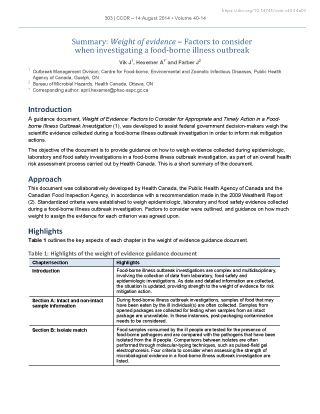Investigating a food-borne illness outbreak

 Download this article as a PDF (548 KB - 3 pages)
Download this article as a PDF (548 KB - 3 pages) Published by: The Public Health Agency of Canada
Issue: Volume 40-14: Ebola, food-borne illness and more
Date published: August 14, 2014
ISSN: 1481-8531
Submit a manuscript
About CCDR
Browse
Volume 40-14, August 14, 2014: Ebola, food-borne illness and more
Guidance
Summary: Weight of evidence – Factors to consider when investigating a food-borne illness outbreak
Vik J1, Hexemer A1* and Farber J2
Affiliations
1 Outbreak Management Division, Centre for Food-borne, Environmental and Zoonotic Infectious Diseases, Public Health Agency of Canada, Guelph, ON
2 Bureau of Microbial Hazards, Health Canada, Ottawa, ON
Correspondence
DOI
https://doi.org/10.14745/ccdr.v40i14a03
Introduction
A guidance document, Weight of Evidence: Factors to Consider for Appropriate and Timely Action in a Food-borne Illness Outbreak Investigation Footnote 1, was developed to assist federal government decision-makers weigh the scientific evidence collected during a food-borne illness outbreak investigation in order to inform risk mitigation actions.
The objective of the document is to provide guidance on how to weigh evidence collected during epidemiologic, laboratory and food safety investigations in a food-borne illness outbreak investigation, as part of an overall health risk assessment process carried out by Health Canada. This is a short summary of the document.
Approach
This document was collaboratively developed by Health Canada, the Public Health Agency of Canada and the Canadian Food Inspection Agency, in accordance with a recommendation made in the 2009 Weatherill Report Footnote 2. Standardized criteria were established to weigh epidemiologic, laboratory and food safety evidence collected during a food-borne illness outbreak investigation. Factors to consider were outlined, and guidance on how much weight to assign the evidence for each criterion was agreed upon.
Highlights
Table 1 outlines the key aspects of each chapter in the weight of evidence guidance document.
| Chapter/section | Highlights |
|---|---|
| Introduction | Food-borne illness outbreak investigations are complex and multidisciplinary, involving the collection of data from laboratory, food safety and epidemiologic investigations. As data and detailed information are collected, the situation is updated, providing strength to the weight of evidence for risk mitigation action. |
| Section A: Intact and non-intact sample information | During food-borne illness outbreak investigations, samples of food that may have been eaten by the ill individual(s) are often collected. Samples from opened packages are collected for testing when samples from an intact package are unavailable. In these instances, post-packaging contamination needs to be considered. |
| Section B: Isolate match | Food samples consumed by the ill people are tested for the presence of food-borne pathogens and are compared with the pathogens that have been isolated from the ill people. Comparisons between isolates are often performed through molecular-typing techniques, such as pulsed-field gel electrophoresis. Four criteria to consider when assessing the strength of microbiological evidence in a food-borne illness outbreak investigation are listed. |
| Section C: Summary of epidemiologic evidence | Direct and supportive epidemiologic evidence is collected throughout a food-borne illness investigation. While the gold standard epidemiologic evidence would arise from a well-designed analytical study, there are other situations in which the weight of evidence would be considered sufficiently strong to warrant regulatory action based on the epidemiologic evidence alone. Nine criteria to consider when assessing the strength of the epidemiologic evidence in a food-borne illness outbreak investigation are listed. |
| Section D: Traceback and traceforward | Once a food has been linked to cases of illness, food safety investigators attempt to determine from where the food originated (traceback) and/or other places to which the food was distributed (traceforward) in order to help inform a risk management decision. Five situations are presented to be used as a guide in obtaining the weight of evidence needed to issue a recall and/or other risk management action(s), to ensure that all contaminated product is identified and that the source of contamination is found. |
| Section E: Health risk assessment | Health risk assessments for microbiological hazards are requested by Canadian Food Inspection Agency technical assessors and/or by provinces and territories, and are performed by Health Canada for food-borne illness outbreak situations. A scientific evaluation team at Health Canada assesses data collected through the laboratory, food safety and epidemiologic investigations and assigns a health risk based on the information that is available at the time of the risk assessment request. |
| Section F: Health risk definitions | The level of health risk is determined by taking the hazard identification, the exposure assessment and the hazard characterization into account. Definitions for the three health risk categories are provided. |
| Section G: Potential risk management actions after a health risk assessment | A number of risk management actions can be undertaken following a health risk assessment. The type of action taken will depend on the level of the health risk and other factors. |
| Section H: Scenario examples | Case studies are provided to demonstrate how the weight of evidence is considered for action in a food-borne illness outbreak investigation. The case studies are provided for guidance only. |
Results
The totality of epidemiologic, laboratory and food safety evidence is evaluated through a health risk assessment, and a health risk level is assigned to the food in question. The weight of evidence guidance document has played a central role in the conduct of health risk assessments, thereby facilitating timely and appropriate risk mitigation action. The document is currently undergoing a process of review, led by Health Canada, and this is scheduled for completion in 2014.
Conclusion
The use of a guidance document with standardized criteria to assess the weight of evidence in food-borne illness outbreak investigations facilitates the timely completion of health risk assessments of suspect food vehicles and informs the implementation of public health actions to mitigate food-borne risks to consumers.
Conflict of interest
No conflicts of interests to declare.
Funding
No external funding was provided.
Page details
- Date modified: